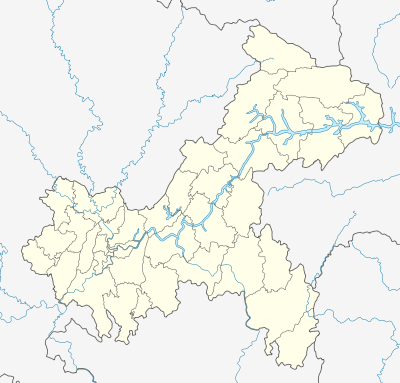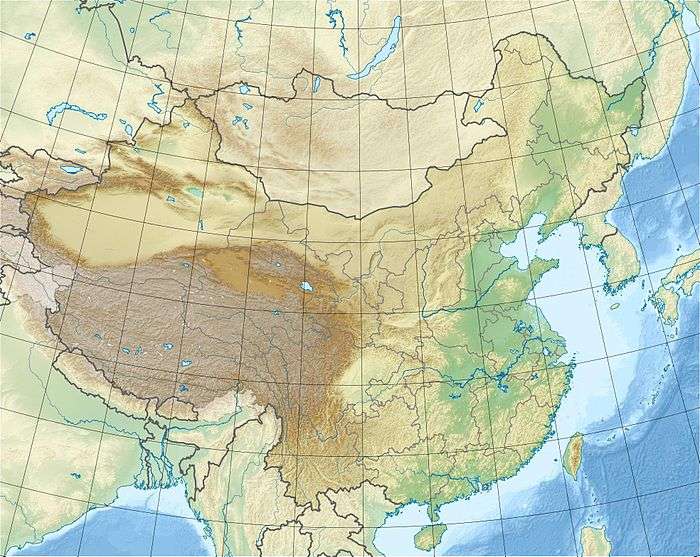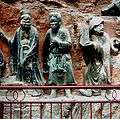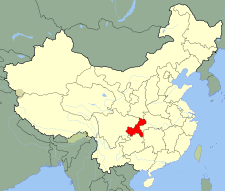Dazu Rock Carvings
The Dazu Rock Carvings[1] (Chinese: 大足石刻; pinyin: Dàzú Shíkè) are a series of Chinese religious sculptures and carvings located in Dazu District, Chongqing, China. The carvings date back as far as the 7th century AD, depicting and influenced by Buddhist, Confucian and Taoist beliefs. Some are in rock-cut cave shrines, in the usual Chinese Buddhist style, but many others are rock reliefs carved into the open rock faces.
| UNESCO World Heritage Site | |
|---|---|
Dazu Rock Carvings on Mount Baoding | |
| Location | Dazu District, Chongqing, People's Republic of China |
| Includes |
|
| Reference | 912 |
| Inscription | 1999 (23rd session) |
| Area | 20.41 ha (0.0788 sq mi) |
| Buffer zone | 211.12 ha (0.8151 sq mi) |
| Coordinates | 29°42′4″N 105°42′18″E |
 Location of Dazu Rock Carvings in Chongqing  Dazu Rock Carvings (China) | |
World Heritage Site
Listed as a World Heritage Site, the Dazu Rock Carvings are made up of 75 protected sites containing some 50,000 statues, with over 100,000 Chinese characters forming inscriptions and epigraphs. The sites are located in Chongqing Municipality within the steep hillsides throughout Dazu County, located about 165 kilometers west of the urban area of Chongqing. The highlights of the rock grotto are found on Mount Baoding and Mount Beishan.
The carvings were listed as a World Heritage Site in 1999, citing "…their aesthetic quality, their rich diversity of subject matter, both secular and religious, and the light that they shed on everyday life in China during this period. They provide outstanding evidence of the harmonious synthesis of Buddhism, Taoism and Confucianism."[2]
History
The earliest carvings were begun in 650 AD during the early Tang dynasty, but the main period of their creation began in the late 9th century, when Wei Junjing, Prefect of Changzhou, pioneered the carvings on Mount Beishan, and his example was followed after the collapse of the Tang dynasty by local and gentry, monks and nuns, and ordinary people during the Five Dynasties and Ten Kingdoms period (907-65). In the 12th century, during the Song dynasty, a Buddhist monk named Zhao Zhifeng began work on the elaborate sculptures and carvings on Mount Baoding, dedicating 70 years of his life to the project.
Off limits to visitors for many years, the carvings were opened to Chinese travellers in 1961 and foreign visitors in 1980. Until 1975, there was only a muddy path between the town of Dazu and the main cluster of carvings. The isolation helped keep the art unharmed during the massive anti-religious vandalism of the Cultural Revolution.[3]
Gallery
 Dazu rock carving on Mount Baoding.
Dazu rock carving on Mount Baoding.- Dazu Bao Ding Mountain Rock Carvings.
- Bao Ding Mountain Buddhas.
- Bao Ding Mountain Circle of Life.
- Golden Hands Buddha at Bao Ding.
- Bao Ding Mountain Buddhas 2.
- Bao Ding Mountain 18 layers of hell.
- Bao Ding Mountain Demons with Rulers of hell.
- Beishan Guan Yin Bodhisattva.
- Beishan Mahamayuri Bodhisattva.
- Beishan detailed Buddhas.
 Bao Ding Mountain Entering Nirvana.
Bao Ding Mountain Entering Nirvana.



See also
- Dazu Lotus Manor, a nearby attraction
- Tianlongshan Grottoes
References
- "Dazu Rock Carvings Baodangshan Site". TripAdvisor. 21 September 2014.
- "Dazu Rock Carvings". UNESCO. Retrieved 21 September 2014.
- Terrill, Ross (January 14, 1990). "Serene Haven of Buddhist Art". The New York Times. Retrieved February 11, 2009.
External links
| Wikimedia Commons has media related to Dazu Rock Carvings. |
- UNESCO World Heritage Centre page
- Wisdom embodied: Chinese Buddhist and Daoist sculpture in the Metropolitan Museum of Art, a collection catalog from The Metropolitan Museum of Art Libraries (fully available online as PDF), which contains material on the Dazu Rock Carvings


